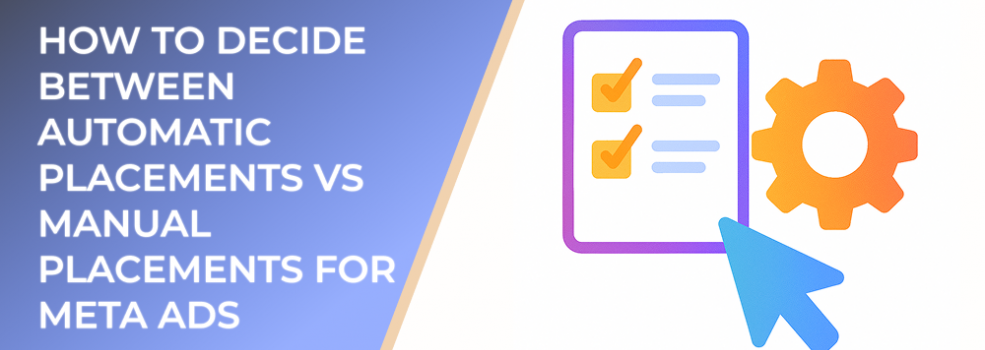Placements decide where your ads appear across Meta inventory: Facebook (Feeds, Stories, Reels, Right Column, In‑Stream, Search, Marketplace), Instagram (Feed, Explore, Stories, Reels), Audience Network, and Messenger. Automatic Placements allow the system to allocate delivery across all eligible surfaces to minimize cost per chosen objective. Manual Placements let you exclude or prioritize surfaces for brand, context, or performance reasons.
Useful statistics at a glance
-
CPM & reach: Automatic Placements (AP) often deliver 10–30% lower CPMs and 12–35% more reach at the same budget versus narrow Manual Placements (MP), due to access to cheaper inventory.
-
Placement skew: In AP, 60–80% of impressions can concentrate in a few low‑cost surfaces (commonly Reels/Stories or Audience Network), which may not always produce the highest purchase rate for complex offers.
-
Conversion variance: Excluding one or two underperforming placements can improve cost per purchase/lead by 8–20%—but over‑pruning can raise costs by 10–25% by restricting supply.
-
Learning sensitivity: Frequent placement edits extend or reset learning, temporarily increasing CPA/CPL by 10–35% for 48–96 hours.
-
Frequency & fatigue: Placement pools with smaller reach (e.g., IG Feed only) can hit frequency >3 in 7 days quickly at scale, often lifting CPC by 15–30%.
Ranges reflect common patterns observed across e‑commerce and lead‑gen accounts; actual results vary by market, creative, and objective.
Quick decision framework
Ask these five questions before choosing AP or MP:
-
What’s the objective? If you optimize for Sales/App Promotion, AP usually wins on efficiency. For high‑consideration lead gen that needs reading time, Feeds‑weighted MP can help quality.
-
Is your creative placement‑native? Vertical, fast hooks (6–10s) → favor Stories/Reels via AP or a vertical‑only MP test. Detailed carousels/long copy → Feeds‑heavy MP.
-
How sensitive is brand context? If you need tighter control (e.g., avoid Audience Network, In‑Stream), start with MP guardrails.
-
What’s the budget & audience size? Small budgets/broad audiences favor AP efficiency. Niche B2B or small geos may need MP to avoid waste.
-
Are you testing or scaling? Use AP for early exploration; once patterns surface, refine with MP exclusions.
When to prefer Automatic Placements (AP)
-
Exploration & new accounts: Let the system hunt for cheap signals and unexpected surfaces.
-
Limited budgets or broad audiences: Maximize delivery and learning speed.
-
Direct‑response with short paths: Lower‑friction funnels (shop now, app install) benefit from extra inventory.
-
Dynamic formats (DPA/ASC): Catalog and Advantage+ Shopping Campaigns are designed to exploit inventory breadth.
-
Creative library built for vertical & feed: If you have versions for Reels/Stories and Feeds, AP can allocate smartly.
Guardrails while using AP
-
Set exclusions only for placements with persistent negative outcomes (e.g., Audience Network for premium brands) after several days of data.
-
Cap total live ads ≤6 per ad set to avoid learning dilution.
-
Monitor placement breakdowns weekly: share of spend, cost per key event, and post‑click quality (ATC rate, qualified lead rate).
When to prefer Manual Placements (MP)
-
Brand safety or context requirements: Exclude Audience Network/In‑Stream if you must. Keep Feeds/IG Explore only.
-
High‑consideration or B2B offers: Prioritize Feeds where users read, save, and click through to longer pages.
-
Performance anomalies: If one placement repeatedly shows 40%+ worse cost per qualified event, exclude and re‑test later.
-
Creative fit limits: Assets that only exist in 1:1/4:5 or rely on detailed overlays work best in Feeds.
-
Geo or language constraints: Constrain to placements where your localized assets exist.
Guardrails while using MP
-
Avoid over‑segmentation; keep enough inventory to deliver and learn.
-
Re‑evaluate exclusions monthly—previously weak placements can become efficient after creative changes.
-
Use separate ad sets to test Feeds‑only vs Reels/Stories‑only if you need clean comparisons.
A simple 14‑day testing plan
Goal: Find a low‑volatility mix that balances cost and quality.
Days 1–3: Baseline AP
-
One ad set with AP, broad audience, 3–4 placement‑native creatives (vertical + feed).
-
No edits for 72 hours; read cost per add‑to‑cart/qualified lead and placement breakdowns.
Days 4–7: Diagnostic pruning
-
If a placement is ≥40% worse on cost per qualified event with volume, create a second ad set with that placement excluded. Keep the original running.
Days 8–10: Feeds‑weighted MP test
-
Create an MP ad set prioritizing Feeds (+IG Explore). Use feed‑native assets.
Days 11–14: Consolidate & scale
-
Keep the best performer; scale +15–20% in steps. Retire the loser. Document results and revisit monthly.
Measurement checklist
-
Keep the attribution window constant across tests.
-
Compare cost per purchase/qualified lead and down‑stream quality (checkout start rate, show‑up rate, LTV where possible), not just CTR.
-
Watch frequency per placement and rotate creatives before fatigue.
-
Annotate any changes (budget, creative count, exclusions) to avoid false reads.
Troubleshooting
-
Cheap clicks, poor buyers: Add a Feeds‑only MP lane or set a minimum Feed share.
-
High CPM after exclusions: Re‑open one low‑cost placement and retest with a better‑fit creative.
-
Learning keeps resetting: Batch edits; change placements no more than once per week per ad set.
-
Reels/Stories dominate but no conversions: Produce clearer vertical assets (price/offer cues, 0–2s hook) or move spend to Feeds MP.
Executive summary
Use Automatic Placements to explore, lower CPMs, and learn fast—especially for short-path conversions and mixed creative libraries. Use Manual Placements when brand context, creative fit, or consistent performance gaps demand control. Validate with a short, structured test and keep your attribution constant to make real comparisons.

